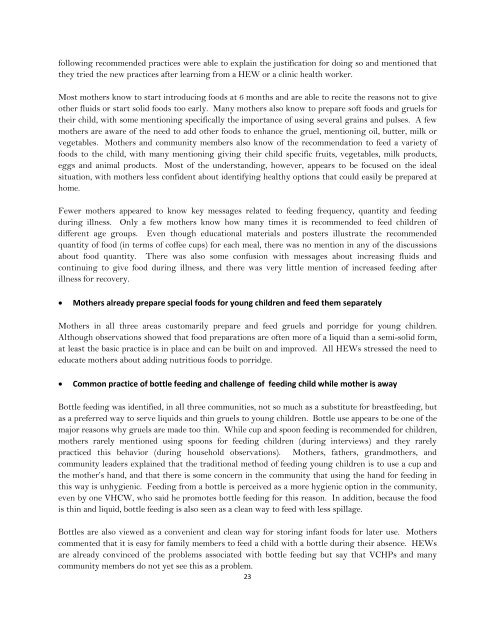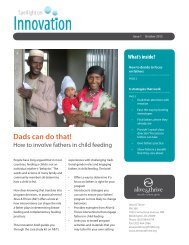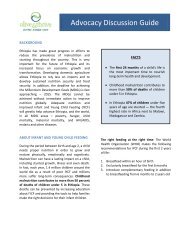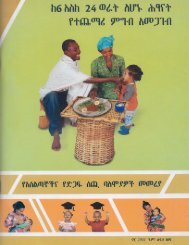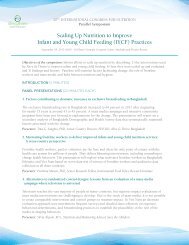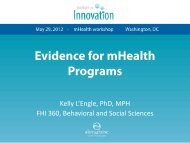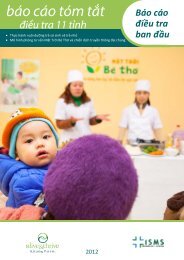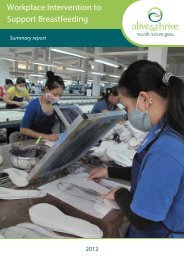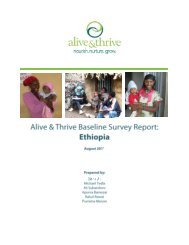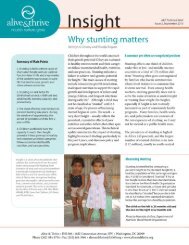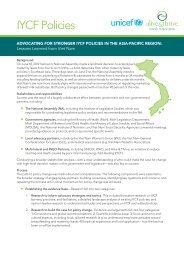IYCF Practices, Beliefs, and Influences in SNNP ... - Alive & Thrive
IYCF Practices, Beliefs, and Influences in SNNP ... - Alive & Thrive
IYCF Practices, Beliefs, and Influences in SNNP ... - Alive & Thrive
You also want an ePaper? Increase the reach of your titles
YUMPU automatically turns print PDFs into web optimized ePapers that Google loves.
follow<strong>in</strong>g recommended practices were able to expla<strong>in</strong> the justification for do<strong>in</strong>g so <strong>and</strong> mentioned thatthey tried the new practices after learn<strong>in</strong>g from a HEW or a cl<strong>in</strong>ic health worker.Most mothers know to start <strong>in</strong>troduc<strong>in</strong>g foods at 6 months <strong>and</strong> are able to recite the reasons not to giveother fluids or start solid foods too early. Many mothers also know to prepare soft foods <strong>and</strong> gruels fortheir child, with some mention<strong>in</strong>g specifically the importance of us<strong>in</strong>g several gra<strong>in</strong>s <strong>and</strong> pulses. A fewmothers are aware of the need to add other foods to enhance the gruel, mention<strong>in</strong>g oil, butter, milk orvegetables. Mothers <strong>and</strong> community members also know of the recommendation to feed a variety offoods to the child, with many mention<strong>in</strong>g giv<strong>in</strong>g their child specific fruits, vegetables, milk products,eggs <strong>and</strong> animal products. Most of the underst<strong>and</strong><strong>in</strong>g, however, appears to be focused on the idealsituation, with mothers less confident about identify<strong>in</strong>g healthy options that could easily be prepared athome.Fewer mothers appeared to know key messages related to feed<strong>in</strong>g frequency, quantity <strong>and</strong> feed<strong>in</strong>gdur<strong>in</strong>g illness. Only a few mothers know how many times it is recommended to feed children ofdifferent age groups. Even though educational materials <strong>and</strong> posters illustrate the recommendedquantity of food (<strong>in</strong> terms of coffee cups) for each meal, there was no mention <strong>in</strong> any of the discussionsabout food quantity. There was also some confusion with messages about <strong>in</strong>creas<strong>in</strong>g fluids <strong>and</strong>cont<strong>in</strong>u<strong>in</strong>g to give food dur<strong>in</strong>g illness, <strong>and</strong> there was very little mention of <strong>in</strong>creased feed<strong>in</strong>g afterillness for recovery.• Mothers already prepare special foods for young children <strong>and</strong> feed them separatelyMothers <strong>in</strong> all three areas customarily prepare <strong>and</strong> feed gruels <strong>and</strong> porridge for young children.Although observations showed that food preparations are often more of a liquid than a semi-solid form,at least the basic practice is <strong>in</strong> place <strong>and</strong> can be built on <strong>and</strong> improved. All HEWs stressed the need toeducate mothers about add<strong>in</strong>g nutritious foods to porridge.• Common practice of bottle feed<strong>in</strong>g <strong>and</strong> challenge of feed<strong>in</strong>g child while mother is awayBottle feed<strong>in</strong>g was identified, <strong>in</strong> all three communities, not so much as a substitute for breastfeed<strong>in</strong>g, butas a preferred way to serve liquids <strong>and</strong> th<strong>in</strong> gruels to young children. Bottle use appears to be one of themajor reasons why gruels are made too th<strong>in</strong>. While cup <strong>and</strong> spoon feed<strong>in</strong>g is recommended for children,mothers rarely mentioned us<strong>in</strong>g spoons for feed<strong>in</strong>g children (dur<strong>in</strong>g <strong>in</strong>terviews) <strong>and</strong> they rarelypracticed this behavior (dur<strong>in</strong>g household observations). Mothers, fathers, gr<strong>and</strong>mothers, <strong>and</strong>community leaders expla<strong>in</strong>ed that the traditional method of feed<strong>in</strong>g young children is to use a cup <strong>and</strong>the mother’s h<strong>and</strong>, <strong>and</strong> that there is some concern <strong>in</strong> the community that us<strong>in</strong>g the h<strong>and</strong> for feed<strong>in</strong>g <strong>in</strong>this way is unhygienic. Feed<strong>in</strong>g from a bottle is perceived as a more hygienic option <strong>in</strong> the community,even by one VHCW, who said he promotes bottle feed<strong>in</strong>g for this reason. In addition, because the foodis th<strong>in</strong> <strong>and</strong> liquid, bottle feed<strong>in</strong>g is also seen as a clean way to feed with less spillage.Bottles are also viewed as a convenient <strong>and</strong> clean way for stor<strong>in</strong>g <strong>in</strong>fant foods for later use. Motherscommented that it is easy for family members to feed a child with a bottle dur<strong>in</strong>g their absence. HEWsare already conv<strong>in</strong>ced of the problems associated with bottle feed<strong>in</strong>g but say that VCHPs <strong>and</strong> manycommunity members do not yet see this as a problem.23


